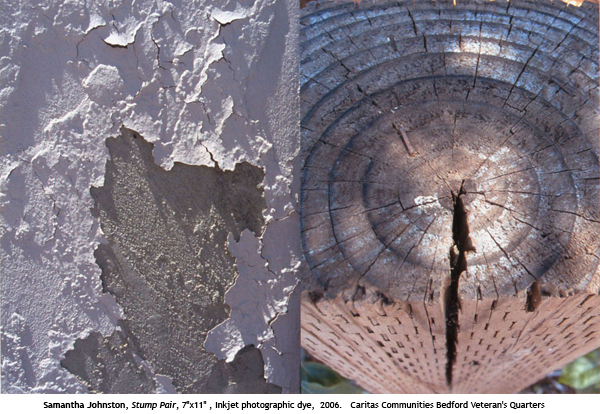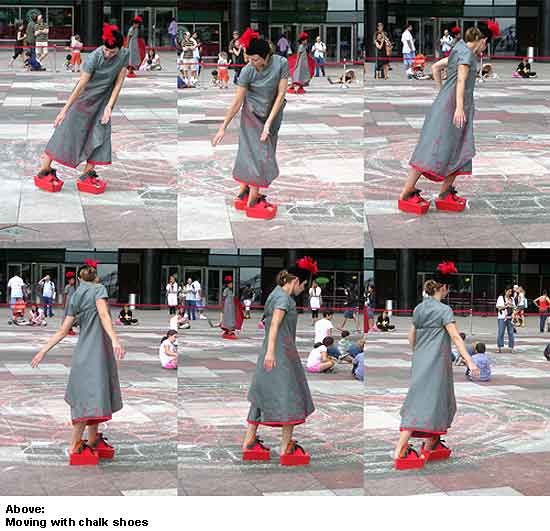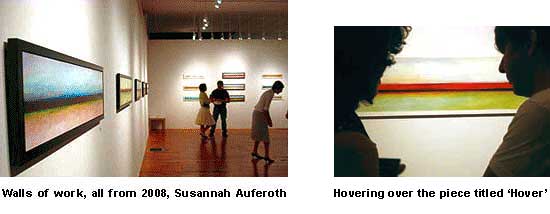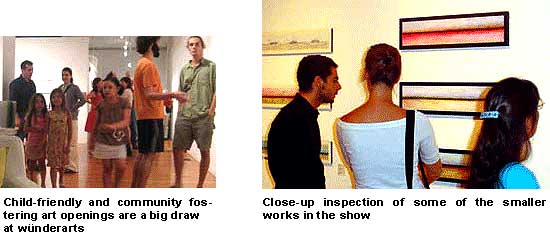Friday, December 5th, 2008
Festival- Hopping ParisSpring, Summer 2008, Slideshow
Angie Eng
If yesterday was “spend,” today is “save.” Economize money, energy, space, time, water, food, thoughts. If I’m not watching images move, or moving images, then by default I’m roaming. A to B, equals New York to Paris. At a discreet global position, vaguely sitting in cafes for hours chatting, discussing, debating. Cartesians: “wearing the clock” not “watching the clock.” Spending vagabond days, writing, editing, reading, but do we, with one glance, have enough information to spark a sequence of ideas, feelings, inspiration?
Le Cube Festival 2008, Issy Les Moulineaux, www.cubefestival.com | Festival Nemo 2008, Élysées Biarritz, www.arcadi.fr | Festival Agora 2008, Ircam, www.ircam.fr | Exit Festival International, MAC Creteil Maisons Des Arts, www.maccreteil.com | VisionSonic, La Générale en Manufacture, www.lespixelstransversaux.net | Vision-R Festival, Mains D’Oeuvres, http://www.mainsdoeuvres.org | Scènes Ouvertes à L’insolite, Le Theatre de la Marionnette, Theatre de la Cité Internationale, www.theatredelamarionette.com
Angie Eng is a media artist who works in video, installation and time-based performance. Her current work draws inspiration from nomadic cultures. Her work has been performed and exhibited at the Whitney Museum at Philip Morris, Lincoln Center Video Festival, The Kitchen, New Museum of Contemporary Art, Renssalaer Polytechnic Institute, Eyebeam Art and Technology Center, Roulette Intermedium and Experimental Intermedia. Her videos have been included in digital art festivals in local and international venues in Cuba, France, Greece, Japan, Holland, Germany, Former Yugoslavia and Canada. She has received numerous grants and commissions: New Museum of Radio and Performing Arts, Harvestworks, Art In General, Lower Manhattan Cultural Council, New York State Council on the Arts, Jerome Foundation and Experimental TV Center.
#permalink posted by Angie Eng: 12/05/08 08:50:00 AMMonday, November 24th, 2008
by Tova Speter
The Art Connection is a Boston nonprofit organization (currently celebrating its 13th anniversary) that seeks to enrich and educate under-served communities by expanding public access to original art. This distinct program places the work of donor artists on the walls of community service organizations. Within these healing environments, the art provides welcome opportunities for reflection, inspiration, comfort and hope. Sometimes, just one painting or sculpture can make a difference. This simple but powerful idea has resulted in thousands of installations into scores of organizations, giving those who often have the least access to art direct contact in their own communities.
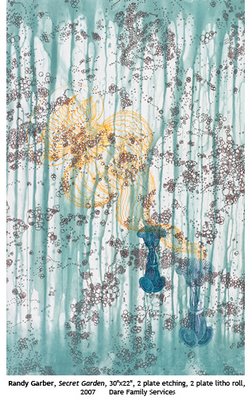 A win-win for both artist and agency – the artwork is seen by many community members annually, often those who do not have regular access to original artwork. The artists feel good about gifting a work that has the potential to really make a difference in the life of someone in need; the agencies feel good about respecting their clients and staff by creating a warm and welcoming environment; and the community members feel good about experiencing artwork firsthand, often when they are accessing services during a difficult time in their lives.
A win-win for both artist and agency – the artwork is seen by many community members annually, often those who do not have regular access to original artwork. The artists feel good about gifting a work that has the potential to really make a difference in the life of someone in need; the agencies feel good about respecting their clients and staff by creating a warm and welcoming environment; and the community members feel good about experiencing artwork firsthand, often when they are accessing services during a difficult time in their lives.
Agencies must qualify for the program through an application process and must provide direct services to an underserved community. Common placements are homeless shelters, health clinics, community centers, and treatment facilities.
Perhaps one of the most significant components of our program, agencies create a selection committee of clients as well as staff to look through the art portfolio and choose the work that is most meaningful to them. In this way – a dialogue is created not only between staff and client, but also between staff and art, and client and art, and vice versa. The selection process is empowering for all involved and allows for a deeper look into artwork and what it means to them.
No need to take our word for it. The program has caused such a stir that it has expanded already to Washington DC and New York City. What people are saying:
Artists: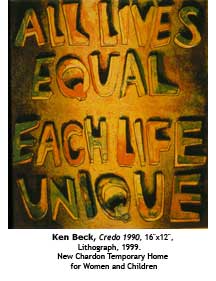 “It fulfills a lot of purposes… one of them is that there is not enough art in public spaces… and from an artist’s perspective, I want people to be looking at art as often as possible.”
“It fulfills a lot of purposes… one of them is that there is not enough art in public spaces… and from an artist’s perspective, I want people to be looking at art as often as possible.” -Ken Beck, artist
“Part of making art is communicating. Work sitting in a closet is not communicating with anybody.”
-Martha Jane Bradford, artist
“It is important to me that my artwork reached appreciative audiences who may have limited opportunities to view original work.”
-Marian Dioguardi, artist
Community members:
“When I walk into a room I’ve never ever been into, I look around and see what’s in it. If there’s lots of art I feel wanted. If there isn’t, I feel lonely.”
-Fifth grade student, Paige Academy
“Both times I was arrested, my mom would never come to visit me. She’d always send someone else to pay my bail and see where I was. But she came here, and she saw this painting (Difficult Decision by Fay Chandler) – and then she came back the next week. She sat at the table, and just looked at that painting. And we talked. I was shocked. I still can’t believe it.”
-Wanda, resident, McGrath House
Agencies:
“If you can’t bring the children to the museums, you need to bring the museums to the children.”
-Bill Walczak, CEO, Codman Square Health Center
“Fine art reveals creativity, imagination, beauty, emotional involvement and intellectual stimulation to all who see it. This is the kind of benefit that says to all our stakeholders, ‘We value you, we appreciate your efforts in treatment an
d recovery.’ The chronically under-resourced public health sector cannot offer luxurious environments, but through donated art, we can help provide a setting that encourages healing and wellness.”
-Carolyn Ingles, Director of Support Services, Metro Boston Mental Health at Shattuck Hospital

Comments from Demetri Yannopolous, Boston Rescue Mission:
The client opens the door panting and sweating. “Man, those stairs always kick my butt,” she gasps. There are six floors in the Boston Rescue Mission, and each floor serves a purpose in helping people recover from homelessness. The halls of the Boston Rescue Mission are filled with emotions: fear, hunger, hope, joy and transformation. They are now also filled with art as The Art Connection has helped make even the walls part of the recovery process. Residents struggle every day to get their lives back in order, but with the help of generous artists, the Mission has become a warmer place.
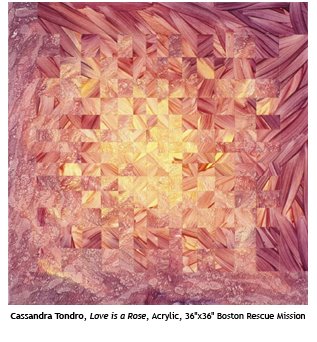 The Boston Rescue Mission has been working on transforming the lives of the poor and homeless since 1899. Reverend John Samaan, President of the Boston Rescue Mission, commented that “We now have splendid pieces of artwork that will brighten people’s lives for years to come.” The artwork now decorates the halls of the Boston Rescue Mission, and clients have begun to take notice and talk about what it means to them emotionally and spiritually. Erica, a client living at the Mission exclaimed that “Every day I face my demons, but the artwork has brought much needed comfort and beauty into my life. It gives me hope.”
The Boston Rescue Mission has been working on transforming the lives of the poor and homeless since 1899. Reverend John Samaan, President of the Boston Rescue Mission, commented that “We now have splendid pieces of artwork that will brighten people’s lives for years to come.” The artwork now decorates the halls of the Boston Rescue Mission, and clients have begun to take notice and talk about what it means to them emotionally and spiritually. Erica, a client living at the Mission exclaimed that “Every day I face my demons, but the artwork has brought much needed comfort and beauty into my life. It gives me hope.”
Art offers all of us an opportunity to experience emotions, thoughts, and feelings that we can’t find elsewhere. It is a chance to escape to new worlds, to engage in discussion, or to gain a spiritual breather. The art donated through The Art Connection now provides the opportunity not only to make a person feel better, but to truly be a part of a person’s life during their road to recovery.
Comments from Marian Dioguardi, donating artist:Donating my art through The Art Connection has always been meaningful for me. It is important to me that my art work reaches appreciative audiences who may have limited opportunities to view original art work. My art’s placement with the East Boston Health Center, this summer, was especially meaningful. You see, I grew up in East Boston selling my crayon drawings door to door to my understanding neighbors on Webster Street. My neighbors were always gracious and generous with me and now it’s my turn to say thank you and give something back to the community.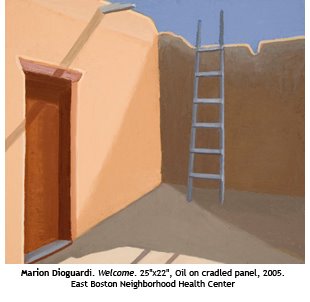 As an active and clumsy child I was an all too familiar face at the EBHC, then known as “The Relief Station”. After asking my ritual question “How many stitches did I get?” I was always relieved and released once again to play, run and inevitably to fall. Now the EBHC continues to play an important part in my life as it cares for my parents Nick and Marie, life long residents of East Boston. Having my work chosen , hanging and welcoming everyone to the East Boston Health Center as me and my family have always been welcome gives me great pleasure. Other info:The Art Connection was established in 1995 as a vehicle for distributing original works of art to public, charitable, and educational institutions, in a manner pioneered by Fay Chandler, a painter and sculptor working in Boston since the early 1970s. As Fay began considering what would happen to her unsold inventory of work at her death or disability, she became convinced that the best result would be transferring the work, in conjunction with the work of other artists, free of charge, to interested public and nonprofit organizations in the community that have no funds for purchasing art. The program grew as founding directors recognized a demand for expanding public access to the visual arts and from their ability to build a unique program to meet that need. Since its inception 13 years ago, this unique gifting program has supported over 250 agencies in their personal selection of over 3700 pieces by 250 artists and collectors.If you are an artist interested in donating work or an agency representative interested in receiving work, please contact us at info@theartconnection.org. Also- check out our new website at www.theartconnection.orgTova Speter, Boston
As an active and clumsy child I was an all too familiar face at the EBHC, then known as “The Relief Station”. After asking my ritual question “How many stitches did I get?” I was always relieved and released once again to play, run and inevitably to fall. Now the EBHC continues to play an important part in my life as it cares for my parents Nick and Marie, life long residents of East Boston. Having my work chosen , hanging and welcoming everyone to the East Boston Health Center as me and my family have always been welcome gives me great pleasure. Other info:The Art Connection was established in 1995 as a vehicle for distributing original works of art to public, charitable, and educational institutions, in a manner pioneered by Fay Chandler, a painter and sculptor working in Boston since the early 1970s. As Fay began considering what would happen to her unsold inventory of work at her death or disability, she became convinced that the best result would be transferring the work, in conjunction with the work of other artists, free of charge, to interested public and nonprofit organizations in the community that have no funds for purchasing art. The program grew as founding directors recognized a demand for expanding public access to the visual arts and from their ability to build a unique program to meet that need. Since its inception 13 years ago, this unique gifting program has supported over 250 agencies in their personal selection of over 3700 pieces by 250 artists and collectors.If you are an artist interested in donating work or an agency representative interested in receiving work, please contact us at info@theartconnection.org. Also- check out our new website at www.theartconnection.orgTova Speter, Boston 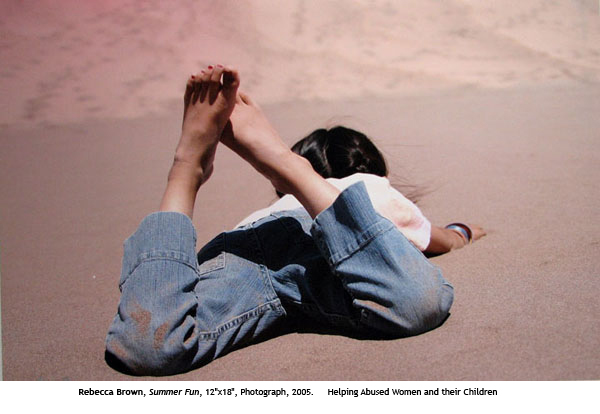
#permalink posted by Erika Knerr: 11/24/08 03:49:00 PMTuesday, November 11th, 2008
Suzanne Fiol at ISSUE Project Room
Old American Can Factory, Brooklyn, NY
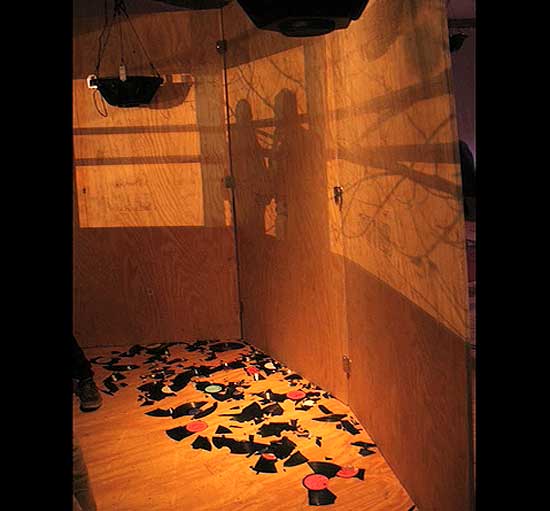
performance at ISSUE Project Room Old American Can Factory
232 3rd Street, 3rd Floor
Brooklyn, NY 11215
An Interview with media artist, Angie Eng
If you’re projecting video on a wrinkled bed sheet, performing on a door in lieu of a table, carting your own mic and mixer, getting lost in the rain by the Gowanus Canal only to roam in circles around a cylindrical room avoiding its audio hot spots, rest assured you’ve found it. ISSUE Project Room is a place where initiates hack such a pilgrimage to meet, hear and see experimental performers. I love New York for such venues. Recently ISSUE Project Room was awarded a twenty year rent free lease on a beautiful 4800 square foot room in Downtown Brooklyn. I interviewed Suzanne Fiol, Founder and Artistic Director, who elaborates about the venue and its unique culture.AE: Please give us a detailed profile of a typical loyal ISSUE Project Room (IPR) fan.
SF: ISSUE’s fan base is all over the map. We don’t have any one typical fan because the kind of work that happens at ISSUE ranges from every type of music from Noise to Chamber music, literature, experimental film and video. What I could say is that the type of person who comes to ISSUE is someone who has a serious connection to the work presented…a person who might be deeply touched by a performance. Possibly a student, possibly a collector, possibly an artist or filmmaker or a pianist.
AE: IPR has been able to not only survive but also thrive in Brooklyn, when just recently many venues could not afford to lose their Manhattan crowd. What are the reasons that set IPR apart from other small experimental music houses?
SF: ISSUE is an artist run organization (though so are Roulette and the Stone which are both fantastic places). Our focus has always been towards the artist, to provide an atmosphere and a safe space where their visions could be realized. Our programming features some of the most accomplished people in their fields, but also emerging artists who are finding their voice. The opportunity for conversations and an informal and warm atmosphere lends itself to new collaborations and new ideas. This kind of energy creates growth and expansion for not just ISSUE Project Room, but for everyone affected by what goes on.
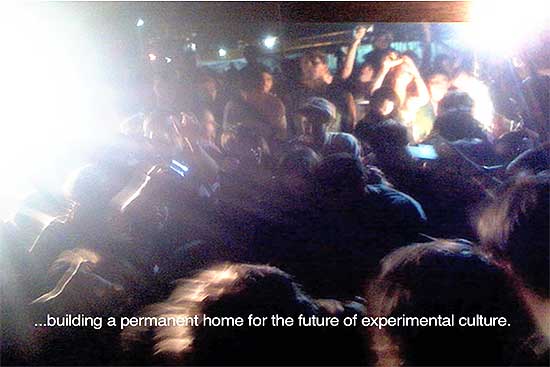
crowds at ISSUE Project Room
SF: ISSUE was recently awarded a 20 year rent free lease on a beautiful 4800 square foot room in downtown Brooklyn. Easily accessible by most subways, this former Elk’s club room in the old Board of Education Building is going to be the most amazing thing you can imagine. We’ve been meeting with the acoustical engineering firm, ARUP, who designed the Sydney Opera House and the Beijing Olympic Stadium to name a few projects and they have been interested in helping us take this space and make it sound completely amazing. It’s quite an uphill battle trying to get in there and raise the funds to restore and treat the space, but trust me…it will be worth it for a generation of people who care about serious culture in New York and sustaining our artistic legacy as New Yorkers.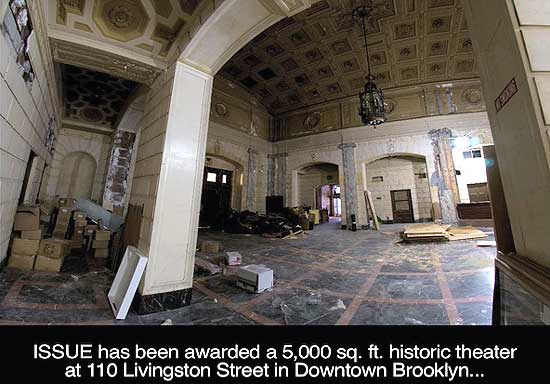 ISSUE Project Room’s new space at 110 Livingston Street, Brooklyn, NY
ISSUE Project Room’s new space at 110 Livingston Street, Brooklyn, NY
SF: ISSUE is dedicated to all forms of artistic expression, while we do tend to feature music, our programming has included many incredible filmmakers, visual artists, poets, novelists, actors and even dancers. Our Artistic Advisory Board includes the great writers Paul Auster, Jonathan Lethem and Bob Holman as well as filmmakers Julian Schnabel and Jim Jarmusch. We’ve been profiled by many magazines and newspapers for our great literary series called “Littoral” which I co-curate with Tony Antoniatis. And just recently we presented a week of “Women in Experimental Cinema” which was very successful and a wonderful program. So I thnk our programming definitely crosses a number of genre boundaries.
AE: Artists are usually asked the same questions they dread posed to them. But if they were not asked of them, they are more than willing to address them voluntarily in a more organic fashion. Such as, what are your models or influences in building IPR? Better yet, what are your models to avoid so as not resorting to the bar for income?
SF: I’ve always been a big fan of Ellen Stewart at La Mama. They have a really fantastic organization and her energy and openness has been a big inspiration. Also we have a very energetic and incredibly supportive board of directors which makes it possible to achieve things that would never be possible through the efforts of one or two people on their own. They’ve helped us in ways I can’t even begin to describe.
AE: You mention collaborating with curators on your site. You have mentioned before that your calendar is based upon thematic months such as ‘vocal month’, ‘percussion month’ ‘multimedia month’. Can you explain the reason for this type of programming based upon musical instruments? Will this continue or what will a month look like in your new space.
SF: Collaborations are a huge part of ISSUE’s mission. Last month we collaborated with Meredith Drum on Women’s Experimental Cinema, with Zach Layton and Nick Hallett for a week of classic avant garde music through their “darmstadt” series. Percussion month was hosted by Billy Martin, one of my favorite percussionists. I think these collaborations yield a huge amount of exciting and fresh ideas and that is what ISSUE is all about. In the new space we will continue these programming models and expand them even further.
AE: I’m a young (25 year old) unknown composer/performer and want a gig at IPR. I just arrived in town and cannot say ‘I’m a friend of so and so’. Do you answer the email/phone still? What is the process of being invited to the new IPR?
SF: Yes, we try to listen to all of the requests that come in via email and so forth. If someone sends us mail we like to listen to the CDs that are included. We ask that people send us a proposal for what they would be interested in doing at ISSUE and if there is a way to fit them into our calendar that makes sense programmatically then we like to introduce new artists to the community. It’s very important to support emerging talent. For instance, ISSUE has an Artist-In-Residence Series that has featured Ashley Paul and Eli Keszler, young and brilliant musicians. They wanted to use their residency as an opportunity to perform with musicians in new york and build alliances. They played incredible sets with Phill Niblock, Aki Onda, David Linton and many other established musicians. Another new talent we’re excited to work with next is Duane Pitre. His work is magnificent…he just sent us a CD. I was listening to it in the car and loved it and invited him to perform…his performance just blew us all away. Now he’s our next Artist in Residence.
AE: The freefall economy is and will affect everyone for a while. You have a lot of courage to start a more ambitious performance space. Where does that courage come from, can you tell us about the magician/yourself behind it all from when you planted the seed until now?
SF: It has always been with me. Since I was in college I remember telling a friend of mine that I was going to make my life surrounded by art and I remember this feeling that I was going to open up a performance space. I was the gallery director of Brent Sikkema for a while and then came ISSUE and it seemed like destiny. It doesn’t necessarily feel like courage, it just feels right. It feels like this is what I’m here for. There’s something honest about this place that I think a lot of people feel too and are drawn to and the power and the courage doesn’t come from me, it comes from everyone. Remember, this is now the Obama generation.
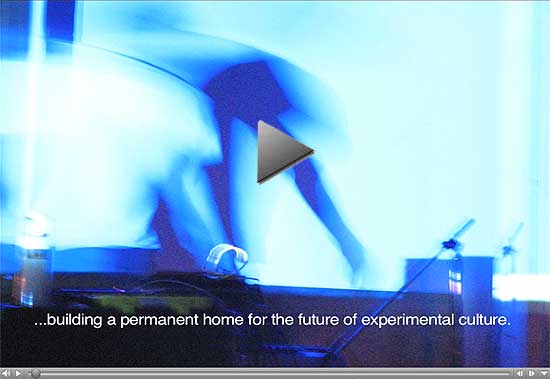
watch a quicktime video of events at ISSUE Project Room
AE: I am coming from the east village to see a concert/performance. It costs me $2 on the metro, $10(maybe $12 or $15 in the new space?) for a ticket and $16 taxi ride to get home (I am 53 years old). I come home with $28-32 less. Why would I go to IPR and not The Stone, Le Poisson Rouge, Roulette, or Bowery Poetry Club?
SF: ISSUE does offer something that these other clubs don’t and they offer something we don’t. There are a lot of people living in Brooklyn, now, remember. Many people are being priced out of Manhattan and are coming over here. For many it’s actually more convenient to stay here than to go to the Village for a concert. So it’s really a balance. The great thing about 110 Livingston is that it is so accessible from Manhattan with almost every subway going right there and is really accessible from Brooklyn too. Besides this, there’s only one space in New York with a 15 channel hemispherical sound system…ISSUE.
AE: When Tonic closed many people felt they lost their second home. You have catered to a similar crowd. Does IPR see themselves as ‘family’ or ‘guest’?
SF: Family
AE: Its 12:30am in Paris, I have about 4 hours to go before I know if Obama wins. I believe in the trickle up effect. If he is elected president, how will that affect IPR?
SF: Well, it shows that this country is heading in a new and positive direction. We’ve felt at times like we were besieged trying to keep expermintal culture alive in the Bush years. Now it’s a new situation, Brooklyn was absolutely beautiful Tuesday night, people were hugging and laughing and crying tears of joy. I think ISSUE represents a place that c
ultivates and sustains culture not denigrates it. The Obama Administration, we hope, will make arts funding a priority. There’s a lot of work for him to do, but we need to keep this up there on the list. Since Reagan, the government has been cutting funding for the arts…we need to change this pattern now.
AE: Better to end an interview on an even number as they say. Far-sighted analogies can be insightful. If IPR were a plant what would it be?
SF: A weeping willow tree.
Angie Eng, NYC/Paris
ISSUE Project Room has received generous support from the Annenberg Foundation, Brooklyn Arts Council, Foundation for Contemporary Arts, The New York City Department of Cultural Affairs, Mary Flagler Cary Charitable Trust, Brooklyn Arts Council, Meet the Composer, The Golden Rule Foundation, The Edwards Foundation Arts Fund, The Puffin Foundation, mediaThe foundation, the Independence Community Foundation, and the Experimental Television Center. BOARD OF DIRECTORS: Marc Zegans, Board Chair, Jo Andres, Steve Buscemi, Suzanne Fiol, Robert Longo, Steve Wax, ART ADVISORY BOARD: Paul Auster, William Basinski, Rhys Chatham, Tony Conrad, David Grubbs, Shahzad Ismaily, Bob Holman, Jim Jarmusch, John Jesurun, Charlotta Kotik, Jonathan Lethem, Evan Lurie, John Lurie, Moby, Rick Moody, Stephan Moore, Lawrence D. Morris, Julian Schnabel, Elliott Sharp, Mark Stewart, Edwin Torres, John Turturro, Kate Valk, Anne Waldman, Hal Willner, Robert Wilson
Angie Eng is a media artist who works in video, installation and time-based performance. Her current work draws inspiration from nomadic cultures. Her work has been performed and exhibited at the Whitney Museum at Philip Morris, Lincoln Center Video Festival, The Kitchen, New Museum of Contemporary Art, Renssalaer Polytechnic Institute, Eyebeam Art and Technology Center, Roulette Intermedium and Experimental Intermedia. Her videos have been included in digital art festivals in local and international venues in Cuba, France, Greece, Japan, Holland, Germany, Former Yugoslavia and Canada. She has received numerous grants and commissions: New Museum of Radio and Performing Arts, Harvestworks, Art In General, Lower Manhattan Cultural Council, New York State Council on the Arts, Jerome Foundation and Experimental TV Center.
#permalink posted by Angie Eng: 11/11/08 08:21:00 AMMonday, September 29th, 2008
Conflux 08The New Beauty: 2008 Conflux Festival
Challenges Ideas of Public Space
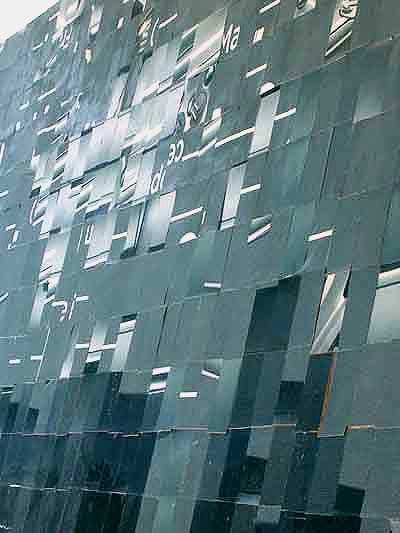 CutUp installation, Center for Architecture photo: Jean Pike
CutUp installation, Center for Architecture photo: Jean Pike
by Jean Pike
Now in its fifth year, the Conflux Festival (Sept 11-14), included works by over 100 artists, geographers, scientists, writers, and architects who were selected from 400 submissions. Conflux is a freewheeling and often ephemeral series of events that are organized around the idea of psychogeography or, as Conflux Co-founder and Director Christina Ray calls it, “finding beauty, surprises and wonder in city spaces.” In opening remarks artist and festival curator Sal Randolph further fleshed this out by quoting Situationist Guy Debord who said “the new beauty can only be a beauty of situations”. Keynote speaker Chris Carlsson, author of Nowtopia: How Pirate Programmers, Outlaw Bicyclists, and Vacant-lot Gardeners are Inventing the Future Today (www.nowtopia.org), put it this way: “when we do these projects it’s the moment when we’re fully engaged…City life has so much that is so possible but is so stunted as far as what could be.”
The dynamic, and sometimes changing schedule coalesced around the festival website at www.Confluxfestival.org and at the Conflux HQ, where lectures, meetings and projects took place, located this year at the Center for Architecture. While zones in the streets of New York were identified for events near the Center for Architecture, many were “off-piste” so to speak, such as those made by Artists Meeting, a group of fourteen artists who made nineteen pieces all over lower Manhattan (www.artistsmeeting.org), or Tango Intervention, organized by artist Ro Lawrence, which gave participants a chance to tango on the Brooklyn Bridge, creating an exciting and different kind of social space for the walkway (www.tangointervention.org).
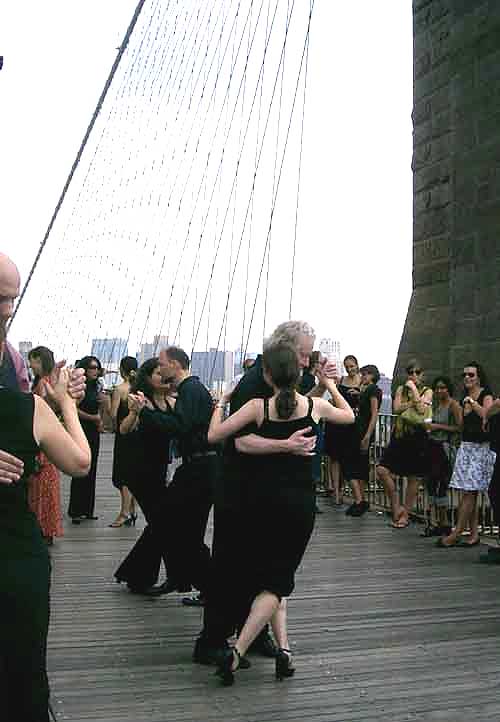 Tango dancers on Brooklyn Bridge photo: Paula K. Lazsus
Tango dancers on Brooklyn Bridge photo: Paula K. Lazsus
In fact, over the weekend lower Manhattan was deluged by a wave of both digital and analog art events, many of which would have been barely perceptible to an unsuspecting public. In a piece called The Pick Up, artists Eleanor Eichenbaum Eubanks and Heather L. Johnson collected personal stories that took place at specific NYC locations, embroidered these memories on over twenty vintage handkerchiefs, and placed the handkerchiefs at the locations where the stories had originally taken place. The idea of making an introduction by way of picking up a handkerchief was resonant in the event. Members of the public are invited to search for these site-specific works and pick them up, using the website map as a guide, but the artists warn, for example, that two handkerchiefs left near the Chelsea Hotel disappeared within a matter of minutes of the drop, making after-the-fact searches potentially futile (www.thepickup.org).
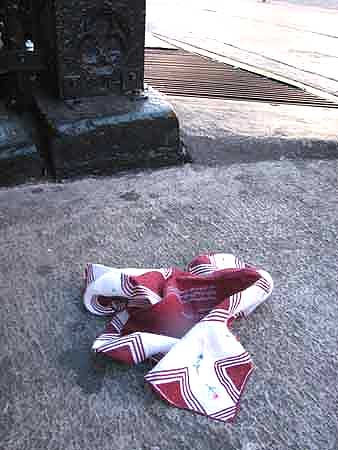 The Pick Up photo courtesy of H.L. Johnson/E.E. Eubanks
The Pick Up photo courtesy of H.L. Johnson/E.E. Eubanks
The anonymous British artists collective, CutUp, was in town and created two new works on downtown billboards at the corners of Grand and Wooster Streets, and West Broadway and Grand as well as an installation in the lobby of the Center for Architecture. Interested in reordering the urban and mediated landscape, their process for the lobby installation included removing a billboard surface whole, cutting it up into 1500 pieces, then reconfiguring to create a desolate landscape. The final image is then viewed through a television that is connected to a CCTV camera. (www.cutup.org)
Brian House, who works with database driven narratives and their intersection with public space and whose work has been incorporated into the curriculum at Columbia’s Graduate School of Architecture, Planning and Preservation, created an interactive video piece called Today is OK that could be viewed by anyone in the vicinity of the Center for Architecture with a cell phone that had Bluetooth capability.
The Federation of Students and Nominally or Unemployed Artists – $1k Giveaway, comprised of artists James Bachhuber, Angela Ferraiolo, Sam Freeman, Tamara Gubernat, Steve Lambert, Michael McCanne, Prescila Neri, Kahil Shkymba, Bob Smith, and Hal Weiss, set up a table over the weekend and gave out free artists grants to the public. Funds had been pooled together by the group from individual work activities leading up to the event. Anyone with a good idea for an art project could stand on line, describe it, put in an application and possibly receive instant funding. Soon local venders decided to join in and give things away as well.
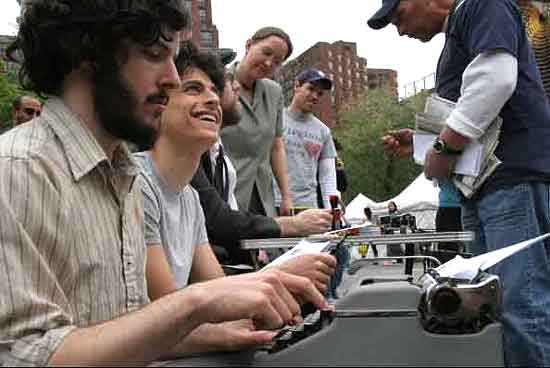 1k Giveaway: receiving a grant application photo courtesy of Steve Lambert
1k Giveaway: receiving a grant application photo courtesy of Steve Lambert
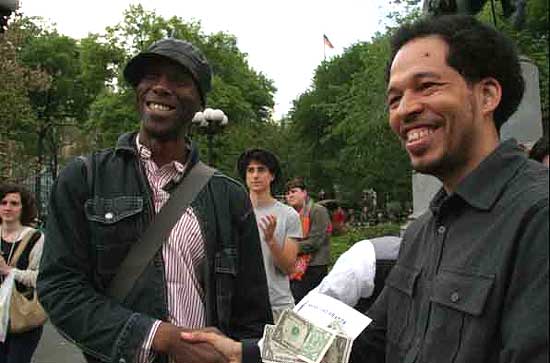 1k Giveaway: a grant is awarded photo courtesy of Steve Lambert
1k Giveaway: a grant is awarded photo courtesy of Steve Lambert
Artist Lee Walton (www.leewalton.com) could be found on Saturday afternoon outside the Strand Bookstore where he was holding an “official” book-signing event. He had come prepared with a chair and a black Sharpie, was willing to sign anyone’s book and would stay as long as was necessary. Walton later gave a talk at the Center for Architecture where he explained how the Conflux Festival had influenced his work by introducing him to the notions of psychogeography. His work has since been commissioned by the likes of Art in General, Reykjavik Art Museum, and the Indianapolis Museum of Contemporary Art, among others. During his Sunday talk Walton passed out about twenty Starbucks Gift Cards explaining that only one of them had money on it which incited a roar of laughter from the audience and a comment from the crowd, “that’s brilliant!” Momentary problems with the internet connection during the talk prompted director and long time friend Christina Ray to call playfully from the back of the room, “That’s part of what we’re throwing at you! It’s called, Your Internet Has Been Dropped!”
Maps and map-making played a big role at Conflux. In a panel discussion that centered around projects that were inspired by the book, Cartography of Protest and Social Change, graphic designer and activist John Emerson, explained that he uses maps to visualize and challenge power and to navigate abstract relationships. He presented the map he created in collaboration with artist/writer Trevor Paglen of the CIA’s secret international flights that transported hostages for rendition. The map was posted on a Santa Monica billboard. Questions such as, “who makes the maps?” and “how do we map ourselves?” were put forward by panel participants as a means of unraveling assumed power structures.
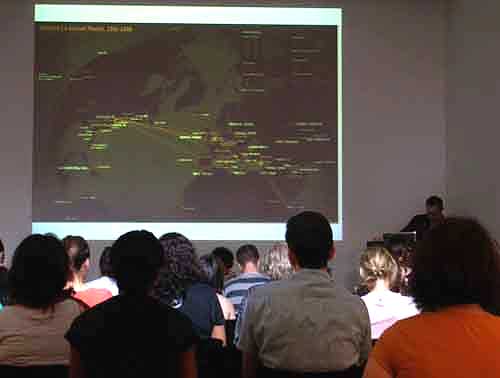 John Emerson presents his map of secret CIA flights
John Emerson presents his map of secret CIA flights
photo: Jean Pike
Artist Lucas Murgida uses the way in which he earns his living, in this case cabinet-making, to make performances and interventions that engage the public and “their notions of service, perception, liberation, and derivations of power”. For this year’s Conflux Festival, in a project called 9/10, referring to the phrase “possession is nine-tenths of the law,” Lucas constructed a cabinet that he then left on a New York City street with himself inside. On Sunday morning, during one of the talks, he was taken. Lucas’ flickr site provided a real time record of his experiences and can be viewed at http://www.flickr.com/photos/lucasmurgida/.
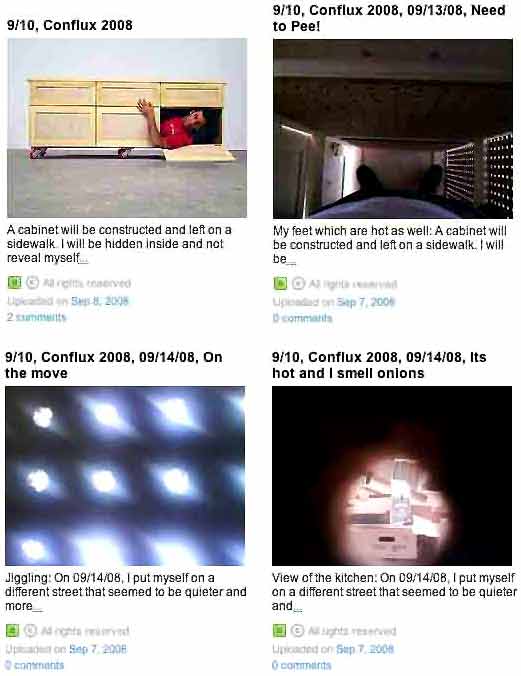 Lucas Murgida in 9/10
Lucas Murgida in 9/10
images courtesy of Lucas Murgida
As Christina Ray now steps away from the Conflux Festival after five years as director, participants and supporters are waiting eagerly to hear what will become of the festival. Conflux is currently in its fifth year with no corporate or public funding, running almost entirely on a grassroots, volunteer basis with only some in-kind donations.
At a time when freedom of the use of “public” space within the City is questionable due to big real estate and corporate interests and homeland security, the projects in the Conflux Festival come as a breath of fresh air, nudging at the edges of the control and ownership of communications systems, of our own habitual activities and the way we operate within the City’s systems. In these events we can see what isn’t normally seen, do what isn’t normally done, and learn about our expectations. Then, as Chris Carlsson says, we can “repopulate the technosphere and reappropriate what we do and why we do it”, a very exciting proposition indeed. Jean Pike is an artist|architect living and working in New York City. She holds a Master of Architecture degree from the Yale School of Architecture. Her work has been shown at Viridian Artists Gallery in NYC, The California College of Arts and Crafts, The University of New Mexico School of Architecture and Planning Gallery, Tao Gallery in Hong Kong and Gallery 61 at The New York Institute of Technology. Her work is about translating between various forms of representation (abstract drawing, video) and three or four dimensional work (sculpture, architecture and installation). Coming from a background in dance, it is often about the physical sense of the body in space and time and how that relates to psychological and emotional states.
#permalink posted by Jean Pike: 9/29/08 11:22:00 AMMonday, September 8th, 2008
J Mandle Performance
The Drawing Center’s ‘The Big Draw’The World Financial Center, NYCby artist|architect Jean Pike
The collective, J Mandle Performance, enlivened the outdoor space of the World Financial Center yesterday with a fun but also poignant piece called hopscotch. Dancers created the underlying line structures (spirals) with cast chalk shoes that were later augmented by kids as they chalked pictures of “safe” and “dangerous” spaces, making a map for a more difficult hopping game. The kids didn’t hesitate for a millisecond as they dove into their task as artists.
The dancers wore highly structured gowns with phrases embroidered on them such as “if you see something”, well known to New Yorkers who are familiar with the MTA’s post-9.11 admonition, “if you see something, say something.”
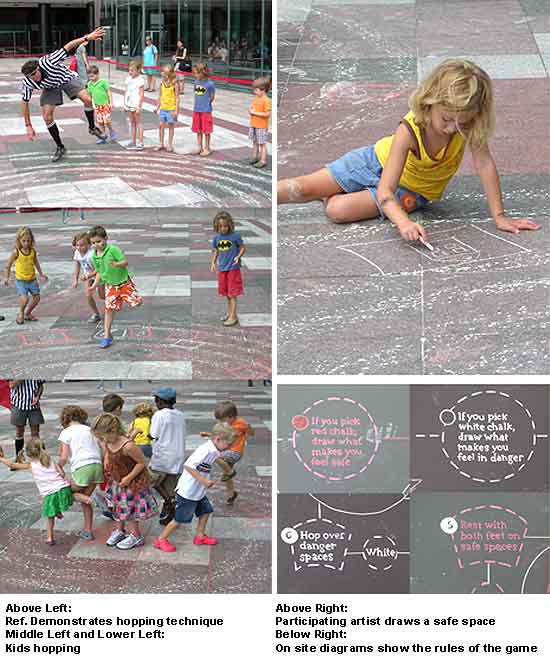
This piece is based on the early French version of hopscotch called Escargot which is played along a spiral path, but Mandle was interested to note that hopscotch originated as a military training exercise in Britain during the Roman Empire and was used to build speed and agility.
About the collective’s work, Mandle says, “I believe in the necessity of public interventions to create small shifts in perception, causing people to turn from one realm of meaning to another.” (interview, artkrush, 09/2007) Hopscotch gave us pause on Saturday.
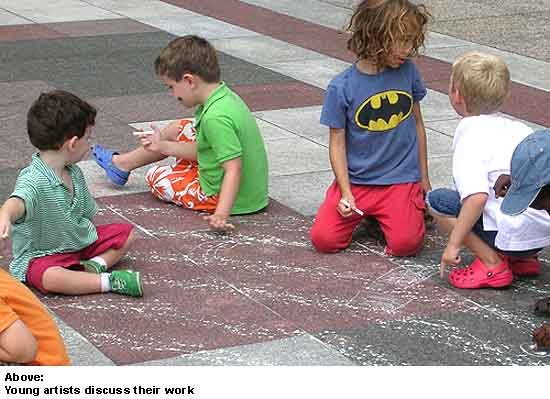
Jean Pike is an artist|architect living and working in New York City. She holds a Master of Architecture degree from the Yale School of Architecture. Her work has been shown at Viridian Artists Gallery in NYC, The California College of Arts and Crafts, The University of New Mexico School of Architecture and Planning Gallery, Tao Gallery in Hong Kong and Gallery 61 at The New York Institute of Technology. Her work is about translating between various forms of representation (abstract drawing, video) and three or four dimensional work (sculpture, architecture and installation). Coming from a background in dance, it is often about the physical sense of the body in space and time and how that relates to psychological and emotional states.
J Mandle Performance creates publicly accessible, often free, site-specific performances that seek to heighten the perception of everyday environments in both invited audiences and accidental passersby. Julia Mandle is the recent recipient of a NYFA Fellowship in Performance Art and numerous awards, including her earliest grant from Franklin Furnace Fund for Performance Art, and later from The Foundation for Contemporary Performance Art, New York State Arts Council and the National Endowment for the Arts. She has also been awarded recent artist?s residencies at Yaddo and Weir Farm Trust. She earned a Bachelor of Fine Arts at Williams College and a Master of Arts at the Gallatin School of New York University.Since founding J Mandle Performance Julia Mandle has pioneered the development of genre-defining, site-specific performance-installation. Named by the New York Times as “a promising force in New York’s art and performance scene”, Mandle seeks to help lead the expansion of performance art in meaningful directions. Hustle (2005) was included in an exhibition voted ‘Best of 2005′ by both Michael Kimmelman of The New York Times and Andrea K. Scott of Time Out NY. Julia has lectured at Rhode Island School of Design anf Pratt Institute, served on the Road Island Arts Council, and published her theories in several journals. She is the recipient of a NYFA Fellowship (2003), grants and awards from the NEA, NYSCA, and the Jerome and Greenwall Foundations, and residencies at Yaddo and Weir Farm Trust. Articles on Mandle’s work have appeared in the New York Times, Time Out New York, the Village Voice, The New Yorker, Architecture Magazine, and NYFA Quarterly.
The Drawing Center has been a unique and dynamic part of New York City’s cultural life since 1977. The only not-for-profit institution in the country to focus on the exhibition of drawings, it was established to demonstrate the significance and diversity of drawings throughout history, to juxtapose work by master figures with work by emerging and under-recognized artists, and to stimulate public dialogue on issues of art and culture. Historical Exhibitions focus on both acknowledged and under-recognized masters (such as Michelangelo, J.M.W. Turner, James Ensor, Marcel Duchamp, and Hilma af Klint) while Contemporary Exhibitions illuminate unexplored aspects of works by major living artists (such as Richard Serra, Louise Bourgeois, Ellsworth Kelly, Anna Maria Maiolino, Ellen Gallagher, and Richard Tuttle), and Selections Exhibitions present innovative work of emerging artists who are contributing to new interpretations of drawing. In the Drawing Room, which was opened across the street from the main gallery in 1997, emerging and under-recognized artists are encouraged to create experimental, cross-disciplinary work and site-specific installations.
#permalink posted by Jean Pike: 9/08/08 09:45:00 PMFriday, August 29th, 2008
Susannah Auferoth at wünderartsAmherst Massachusetts
GIFT
by correspondent, Richard Lloyd
Susannah Auferoth’s exhibition of new paintings opened recently at the wünderarts Gallery in Amherst Massachusetts. wünderarts is a new gallery in Western Mass. They have planted their flag in the ground and are staking out a territory all their own in the Pioneer Valley gallery scene. These new paintings are vigorous and if you live in the area I recommend you make your way to the gallery to see them in real time and place.
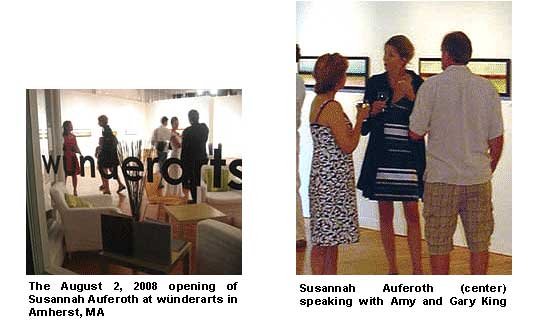
In her published statement about the work, Auferoth describes a process of layering thin washes of color one on top of the other. The results are beautiful. Auferoth is a colorist. She mentions Richard Diebenkorn, and Philip Taaffe as touchstones. Here she continues her own exploration of subtle color manipulation on an intimate and delicate plane. The paintings are deceptively simple in appearance. Three luminous bands of color run horizontally and form a foreground, background and a horizon line that bisects the painting in the center. The horizon line is a band unto itself and typically darker and more ominous.
When looking at these works my initial association is: landscape.But whose landscape? The paintings are windows into the world we share today. What do you see? Is this the Thai beach sunrise for a twenty-something post-grad tourist? Or is it sunset on the killing fields of Darfur? Is it Hadley or Osetia? To my eye the paintings flicker between all these places.
Their size is important. They feel like scrolls that have been placed sideways on the wall. Long and horizontal yet small enough to be seen all at once. The events depicted here are ongoing, they haven’t ended and the beginnings are far, far away. Think of what happens to what you see if you are moving fast enough – a smudge of colors all being pushed together in a fat line across your cones and rods; or when you stare at a blade of grass long enough and something similar happens. These paintings are peepshow slots into that world.
In some of the paintings you can see serialized images buried in the ground of the work behind the bands of horizontal color. This sets up an optical back-and-forth that animates the surface. What are these images? – and what are they doing there? Auferoth is dropping hints. It feels as though we are listening to a hushed conversation in the next-door motel room. The walls are thin but the actual words are still indistinct. You will need your intuitive channels opened up and humming.
These works speak to the traveler in us all. They are simultaneously hopeful and foreboding. I kept being thrown back and forth on an emotional Tilt-a-Whirl; one moment staring at the world – post-apocalypse, empty, lifeless and still, and at the next blink standing at the edge of a new world – full of nascent life, on the verge of becoming.
current exhibition through September 7
Susannah Auferoth, who has both a mechanical engineering and fine arts degree from UMASS Amherst, returned with her family to the Valley from New York City in 2001, and lives and works in a historic farmhouse in Hatfield that she and her husband have updated to suit their family’s lifestyle. The artist works in her home studio where she creates paintings on paper and wood panel that explore color, form, and meaning. While their horizontal orientation and bands of color evoke more traditional land or waterscapes, the inclusion of repeated images or figures in Auferoth’s paintings adds a layer of complexity and mystery while increasing the inherent abstraction of the works.
Richard Lloyd lives and works in Northampton Massachusetts.wünderarts (wunderarts.com) is located at 383 Main Street in Amherst, Massachusetts, is currently exhibiting GIFT, featuring paintings by Susannah Auferoth and Hillary Milens. The show, also marking the gallery’s one-year anniversary, opens with a reception on Saturday, August 2 from 6-9 p.m. and runs through September 7. Hillary Milens, a graduate of UMASS’ Fine Arts program, and the Executive Director of the Amherst Community Art Center was born and raised in Burlington, Vermont. After concentrating mainly in sculpture while at UMass, she began experimenting with drawing and painting. An exploration of surface, texture, and color, her paintings are made by building up and breaking down the surface of wood by applying layers of paint, scraping in
to it and marking the surface with various tools and techniques. An interest in repetition, organic form and the meditative process are present in the paintings. In addition, works by Italian artist Alberto Mancini based on his concurrent exhibition of paintings – I’ll tell you how the Sun rose – inspired by the poetry of Emily Dickinson, will be on view in the rear of wünderarts for the duration of GIFT. Mancini’s show, on view from August 2 – 10 at the Eli Marsh Gallery at Amherst College, is sponsored by the Emily Dickinson Museum, and includes 29 paintings inspired by Dickinson’s poetry. The exhibition is part of the 20th anniversary of the Emily Dickinson International Society (EDIS), which holds its annual meeting in Amherst on the weekend of August 1. For more information on Mancini and the exhibition, please visit www.emilydickinsonmuseum.org.
#permalink posted by Richard Lloyd: 8/29/08 05:56:00 PMMonday, August 25th, 2008
CAMOUFLASH – DRESDEN
Curators:
Mariusz Sołtysik, Aurelia Mandziuk and Anja Tabitha Rudolph
Organizator: UNOACTU
co-organizar: PATIO Art Center, Academy of Humanites and Economics in Lodz.
http://www.unoactu.org/en_camouflash.html
http://patio.art.pl/wystawa.php?id=40
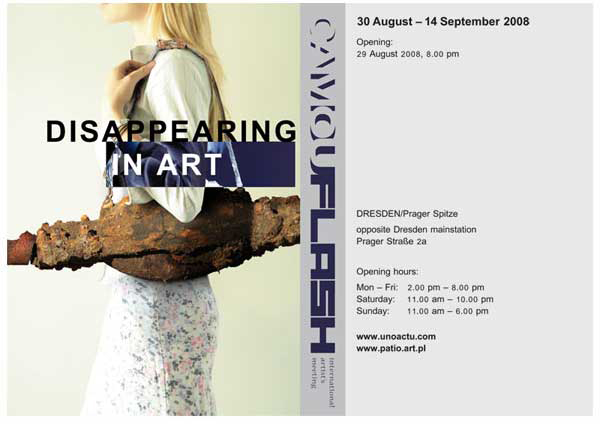
SHILPA GUPTA (India), KATHERINE BEHAR (USA), ALLAN HUGHES (Northern Ireland), REINIGUNGSGESELLSCHAFT (Dresden), JANUSZ BALDYGA (Poland), ERIC VAN HOVE (Belgium), HARRO SCHMIDT (Hanover), MARIUSZ OLSZEWSKI (Poland), ULU BRAUN (Berlin), MARKUS HUEMER (Berlin), AKI TARR (Dresden), DANIEL BIESOLD (Berlin), SUZY SUREK (USA), TAKAKO KIMURA (Japan), YOSHIAKI KAIHATSU (Japan), ERIKA KNERR (USA), DANIEL RODE (Dresden), ANDREAS SACHSENMAIER (Berlin), OLGA BERGMANN (Iceland), TATSUYA HIGUCHI (Japan), ARIANNE OLTHAAR (Netherlands), DIETER LUTSCH (Berlin), CHRISTINE MACKEY (Ireland), KRISTAPS GULBIS (Latvia), ANDRÉ MAROSE (Berlin), ANNA MACLEOD (Ireland), BERND IMMINGER (Berlin), JESSICA HIGGINS (USA), MARTIN BRAZINA (Czech Republic), EWA SZCZYREK-POTOCKA (Poland), GABRIELE HORNDASCH (Düsseldorf), MARIUSZ SOLTYSIK (Poland), MIYUKI YOKOMIZO (Japan), TOMASZ WENDLAND (Poland), BOSSE SUDENBURG (Berlin), TOMASZ MATUSZAK (Poland), ADAM KLIMCZAK (Poland), PIA MÜLLER (Düsseldorf), AISLING O´BEIRN (Northern Ireland), TOBIAS HANTMANN (Cologne), GRIT RUHLAND (Wuppertal), CHARLIE CITRON (USA), SARA PFROMMER (Dresden), NÁNDOR ANGSTENBERGER (Berlin)
CAMOUFLASH Cinema:
DISORIENTALISM (USA), DONG JOO LEE (South Korea), LUKASZ OGOREK (Poland),
KRZYSZTOF LUKOMSKI (Poland), SARAH BROWNE & GARETH KENNEDY (Ireland), AGNIESZKA CHOJNACKA (Poland), MARINA NAPRUSHKINA (Belarus), HENRIK BUSCH (Dresden), RICHARD THOMAS (Australia), WIKTOR POLAK (Poland), SUSANA PEDROSA (Portugal), CARLOS ALBERTO CARRILHO (Portugal)
Concept/Realisation Entry:
NEULANT VAN EXEL (Berlin)
The group UNOACTU based in Dresden, Germany, in cooperation with the Patio Art Centre Lodz, Poland is presenting the exhibition CAMOUFLASH – DISAPPEARING IN ART to open this friday 29 August, 2008. CAMOUFLASH began as an international artist’s meeting that was led by polish artist and curator Marius Soltysik, in Lodz, that I covered in October 2007.
For Dresden Soltysik’s concepts were used and the original group from Lodz is all exhibiting here. UNOACTU has broadened the theme that Mariusz began, based on concepts of Baudrillard’s theories. They have compared the ideas of other philosophers working in this arena, as well as consciously picked a location right next to the shopping mall across from the central train station in Dresden, which instantly underscores the theme. This project has created an intensive exchange between German and Polish artists.
More than 50 works of contemporary art will be exhibited in the building “Prager Spitze,” by artists from Japan, the USA, Australia, India and several European countries.
Many of the artists are arriving now to set up their installations and prepare for the opening. Another artist from New York, Katherine Behar, will begin a performance starting at the former Zentrum Warenhaus down the Prager Straße to the Prager Spitze, an hour before the official opening at 8 pm. Other talks, performances and a concert will follow.
MEDIATIONS Biennale in Poznan (www.mediations.pl) will present a selection of the artworks – about half of the exhibition – in October 2008.
Camouflash
The Disappearing in Art
Camouflash generates significant meaning through the combination of the words “camouflage” and “flash” which describes a paradox or convergence of opposites. “Camouflage” means both camouflage and hidden nature, and, “flash,” means a spark – an outstanding moment or message that is visible only for a short moment. This is an allusion to the schizophrenia of modern human beings in the society of media communication and public performance. Their endeavour culminates in competing moments, those of hiding and those enabling them to stand out in the crowd for a short moment – to gain identity for an instant. This topic is presented to the public directly in one of those places – where this schizophrenia is celebrated in a pre-eminent manner – within a shopping centre across from the main station in Dresden.
The subtitle “Disappearing in Art” departs from Baudrillard’s conceptual background. The entrance of the worlds of simulation and a matrix, sounded merely apocalyptic in the philosophy of the 80’s. The disappearing in the arts gives evidence to a process that existed in the past. If it is possible to pause, then options could appear that are yet unknown and altogether different than the proclaimed tendencies leading to an abrupt ending. The double meaning of the subtitle leads us to contradicting possibilities of interpretation. There opens space for associations creating significance. The merging of the dimensions of reality and arts into each other and the entailed reduction of their operation fields and efficiency might be interpreted, as well as simply dealing with this topi
c in the arts. Whereby the second in particular, enables a sober reflection of the process itself.
MS & ATR
#permalink posted by Erika Knerr: 8/25/08 06:21:00 PM
